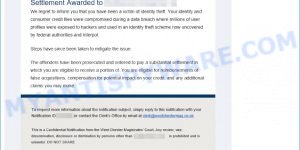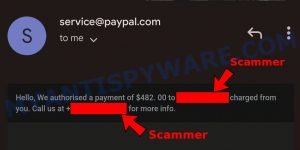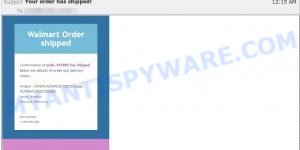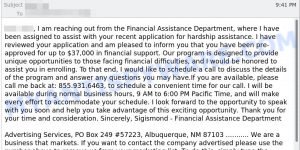In today’s world, scam emails are becoming increasingly common, with scammers using a variety of tactics to try and trick unsuspecting victims into handing over personal and financial information. One such scam that has been recently identified is the “Reconfirm Shipping Documents” scam, which targets individuals or companies involved in shipping and logistics. In this scam, the victim receives an email that appears to be from a legitimate shipping company, requesting them to reconfirm shipping documents before goods are dispatched. However, upon closer inspection, the email contains malicious attachments designed to steal personal and financial information. In this article, we will take a closer look at the “Reconfirm Shipping Documents” scam, how it works, and what you can do to protect yourself from falling victim to this type of scam.
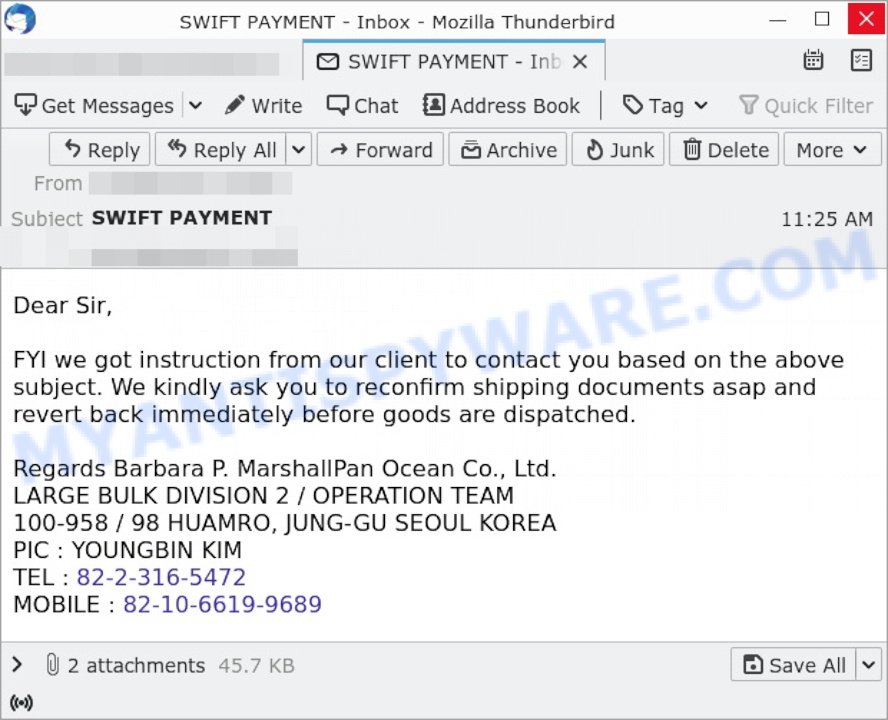
QUICK LINKS
- How the Reconfirm Shipping Documents scam works
- What to do if you receive the Reconfirm Shipping Documents scam email
- How to spot and avoid such scams
How the Reconfirm Shipping Documents scam works
The “Reconfirm Shipping Documents” scam is a type of phishing scam that targets individuals or companies involved in shipping and logistics. The scam typically begins with an email that appears to be from a legitimate shipping company or freight forwarder. The email usually contains a sense of urgency, with the sender requesting the recipient to reconfirm shipping documents immediately before goods are dispatched.
The email may also include details about the shipment, such as the type of goods being shipped, the destination address, and the expected delivery date. The goal of the email is to convince the recipient that the request for document verification is legitimate and urgent.
The email also includes one or more attachments, usually in the form of HTML or PDF files. These files are typically disguised as payment slips, invoices, or other shipping-related documents. However, upon opening these attachments, the victim is prompted to enter sensitive information such as passwords, login credentials, or financial information.
These attachments are flagged by VirusTotal as malware:
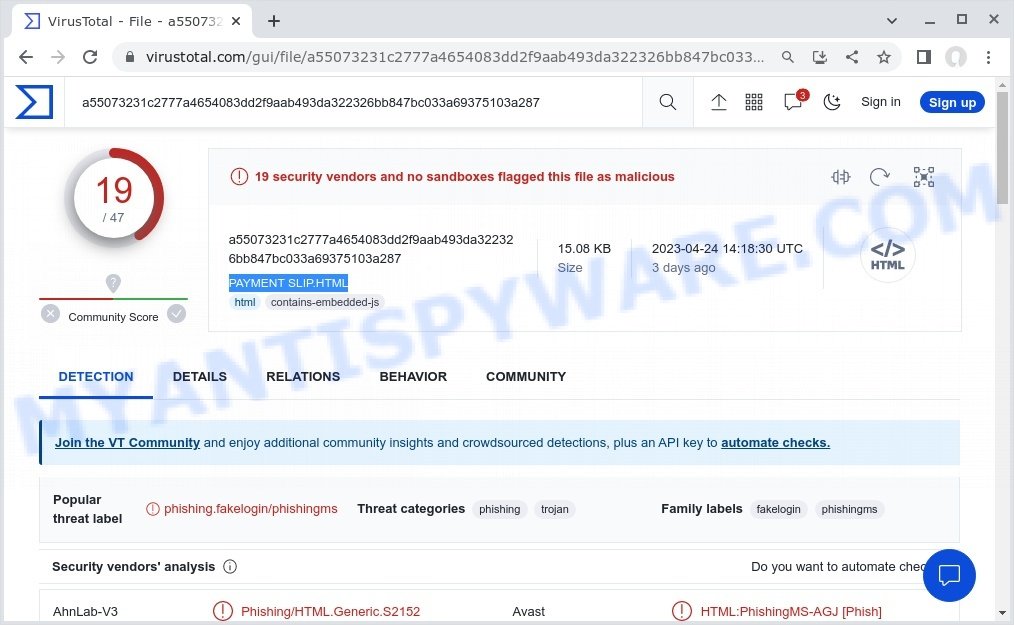
Once the victim enters this information, the scammer behind the email can then use it to commit identity theft or financial fraud. The scammer may use the victim’s information to make unauthorized purchases or to access sensitive accounts, such as banking or credit card accounts.
A typical Reconfirm Shipping Documents Scam Email reads as follows:
Subject: SWIFT PAYMENT
Dear Sir,FYI we got instruction from our client to contact you based on the above subject. We kindly ask you to reconfirm shipping documents asap and revert back immediately before goods are dispatched.
Regards Barbara P. MarshallPan Ocean Co., Ltd.
LARGE BULK DIVISION 2 / OPERATION TEAM
100-958 / 98 HUAMRO, JUNG-GU SEOUL KOREA
PIC : YOUNGBIN KIM
TEL : 82-2-316-5472
MOBILE : 82-10-6619-9689
Here are the step-by-step details of how the “Reconfirm Shipping Documents” scam works:
- The victim receives an unsolicited email from the scammers, purporting to be from a legitimate shipping company, in this case, Pan Ocean Co., Ltd.
- The email requests the victim to reconfirm shipping documents urgently, usually citing a reason such as the goods being ready for dispatch or held up at customs.
- The email contains attachments (in this case PAYMENT SLIP.HTML, PAYMENT SLIP2.HTML) that appear to be legitimate shipping documents, such as invoices or payment slips, but are actually malicious files designed to steal the victim’s sensitive information.
- When the victim opens the attachment, they are prompted to enter a password to access the confidential information contained within.
- Once the victim enters the password, the malicious file records the sensitive information, such as login credentials, credit card details, or personal identification information.
- The recorded information is then sent to the scammers behind the email, who can use it for various nefarious purposes, such as identity theft or financial fraud.
- If the victim falls for the scam, they may experience serious consequences, such as unauthorized transactions, compromised personal information, or even reputational damage.
In summary, the “Reconfirm Shipping Documents” scam is a type of phishing scam that preys on individuals or companies involved in shipping and logistics. The scam uses a sense of urgency to trick victims into opening malicious attachments and entering sensitive information, which can then be used by scammers for fraudulent purposes. It is important to exercise caution and be vigilant when receiving unsolicited emails, especially those that ask for sensitive information or require you to open attachments.
Examples of such scams
Unfortunately, the ‘Reconfirm Shipping Documents’ scam is just one of many similar types of scams that cybercriminals use to steal personal and financial information from unsuspecting victims. These types of scams often rely on social engineering tactics, such as urgency or fear, to trick victims into divulging sensitive information. Here are some other examples of scams that operate in a similar manner: Financial Assistance Department Scam Email, Cash Settlement Awarded Email Scam, and Geek Squad Email Scam.
- Cash Settlement Awarded Email Scam
- BNC Billing Canceled Invoice PayPal Email Scam
- Walmart Order Shipped Email Scam
- Financial Assistance Department Email Scam
- Avira Assistance PayPal Scam Invoice Email
What to do if you receive the Reconfirm Shipping Documents scam email?
Here’s some guidance on what to do when you receive the ‘Reconfirm Shipping Documents’ scam email:
- Don’t click on any links or download any attachments in the email, as they may contain malware that could infect your computer or steal your personal information.
- Delete the email immediately. Do not reply to the email or engage with the sender in any way.
- Report the email to your email provider as spam or phishing, so that they can take appropriate action to block similar emails from reaching your inbox in the future.
- If you have already clicked on a link or downloaded an attachment from the email, run a full virus scan on your computer using reputable antivirus software.
- If you believe that your personal or financial information may have been compromised as a result of the scam, contact your bank or credit card company immediately to report the incident and take steps to protect your accounts.
Remember, scammers often use social engineering tactics to create a sense of urgency or fear in their victims, so it’s important to stay calm and think before you act when receiving unsolicited emails or requests for sensitive information. By following these steps, you can help protect yourself from falling victim to the ‘Reconfirm Shipping Documents’ scam and other similar types of scams.
Threat Summary
| Name | Reconfirm Shipping Documents Scam |
| Type | Phishing |
| Fake Claims | Urgent request to reconfirm shipping documents before goods are dispatched |
| Scammers’ Phone Numbers | Urgent request to reconfirm shipping documents before goods are dispatched |
| Disguise | Email from a fake Walmart |
| Scammers’ Phone Numbers | +82-2-316-5472, +82-10-6619-9689 |
| Detection Names (Attachments) | PAYMENT SLIP.HTML (HTML:PhishingMS-AGJ [Phish]), PAYMENT SLIP2.HTML (HTML:PhishingAdb-HG [Phish]) |
| Damage | Malware infection, stolen personal and financial information |
| Distribution | Email spam, targeted attacks |
| Indicators of the Scam | Unsolicited email from unknown sender, urgent tone, attachments containing malware |
| Prevention Tips | Don’t click on links or download attachments, delete suspicious emails, report spam or phishing to email provider |
| Reporting Info | Report incidents to your bank or credit card company, the FBI’s Internet Crime Complaint Center (IC3), and the Federal Trade Commission (FTC) at reportfraud.ftc.gov. |
How to spot and avoid phishing scams like the Reconfirm Shipping Documents Scam
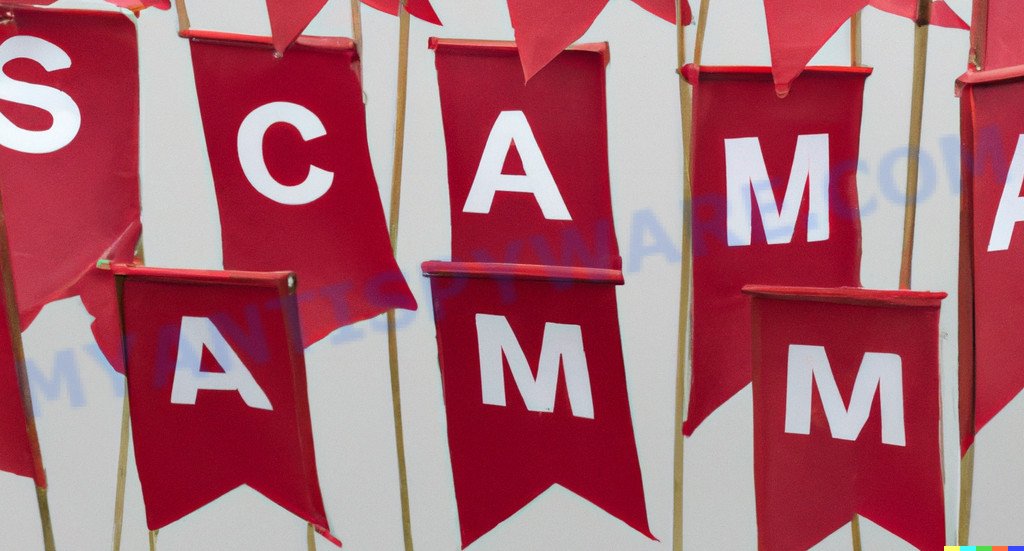
Knowing how to spot and avoid scams like the Reconfirm Shipping Documents Scam is an important skill that can help you protect yourself from identity theft, fraud, and other forms of cybercrime. Here are some tips for spotting and avoiding these types of scams:
- Check the sender’s email address. Scammers often use email addresses or phone numbers that look similar to those of legitimate companies, but with slight variations. Be sure to double-check the sender’s email address or phone number to ensure that it is legitimate.
- Look for poor grammar, spelling errors and typos, which are often indicators of a scam. Legitimate companies typically have professional and polished communications.
- Verify the information. Before taking any action, verify the information in the email by checking the company’s official website or calling their customer service line. Don’t use the phone number provided in the email, as it may be fake. Instead, use the official contact information found on the company’s website.
- Be cautious of unsolicited emails. If you did not expect to receive an email from Intuit, be cautious. Scammers often use unsolicited emails to trick people into providing personal or financial information.
- Be wary of attachments. Avoid downloading attachments unless you are sure they are safe. Instead, confirm the invoice details through official channels.
- Protect your personal information. Don’t give out personal or financial information in response to an email, even if it appears to be from a legitimate company. Legitimate companies will never ask you to provide sensitive information like passwords or credit card numbers over email.
- Trust your instincts. If something seems suspicious or too good to be true, trust your instincts and be cautious. Never give out personal or financial information unless you are sure the request is legitimate.
Conclusion
In conclusion, the “Reconfirm Shipping Documents” scam is a dangerous phishing email that is designed to steal sensitive information from its victims. By understanding how this scam works, and by following the tips and advice outlined in this article, you can protect yourself and your organization from falling victim to such scams. If you receive an email that looks suspicious, it’s always best to err on the side of caution and take the necessary steps to verify the authenticity of the message. Remember, prevention is always better than cure. So, make sure to stay vigilant and stay safe online. Be sure to read the previous sections of this article for more information on how to spot and avoid such scams, what to do if you receive the “Reconfirm Shipping Documents” scam email, and some examples of similar scams to watch out for.
